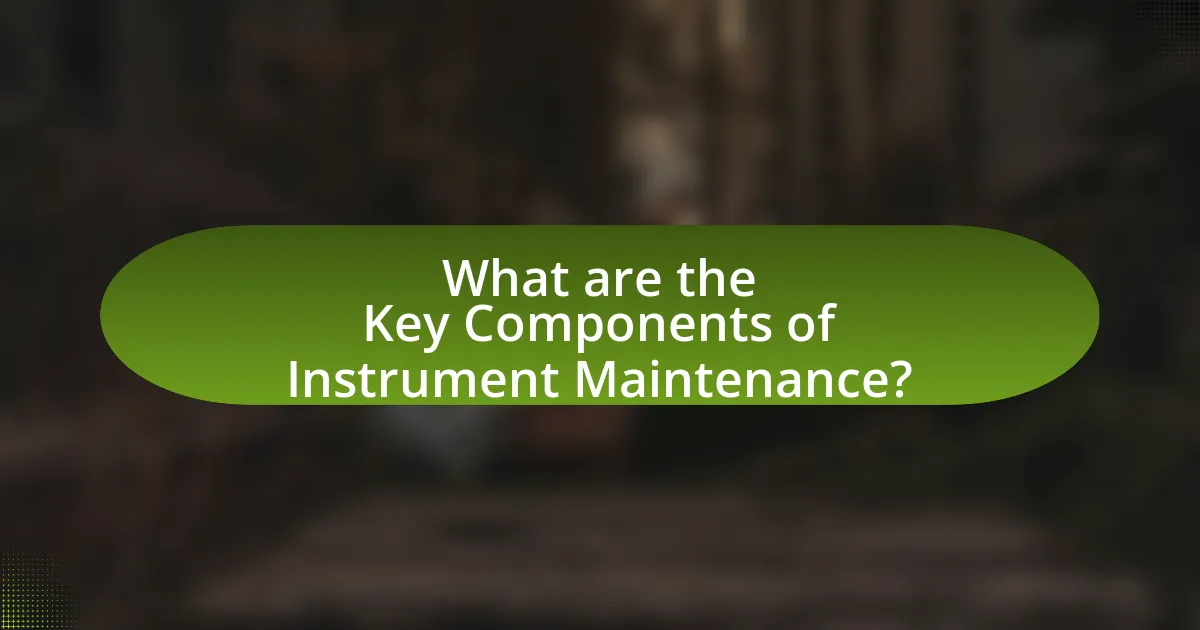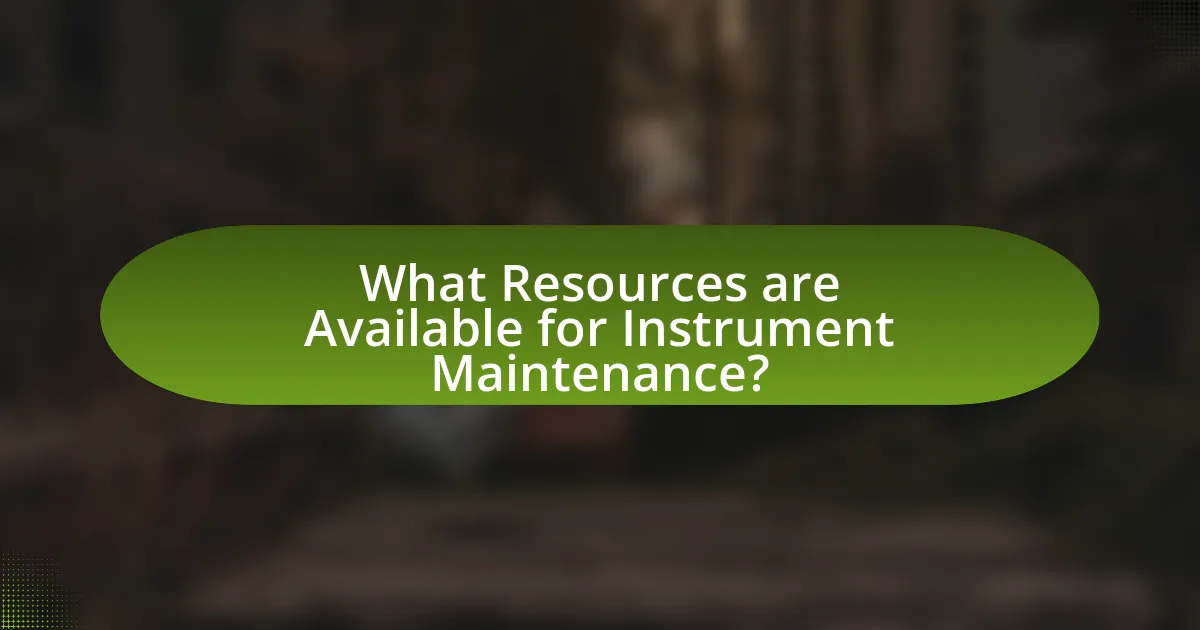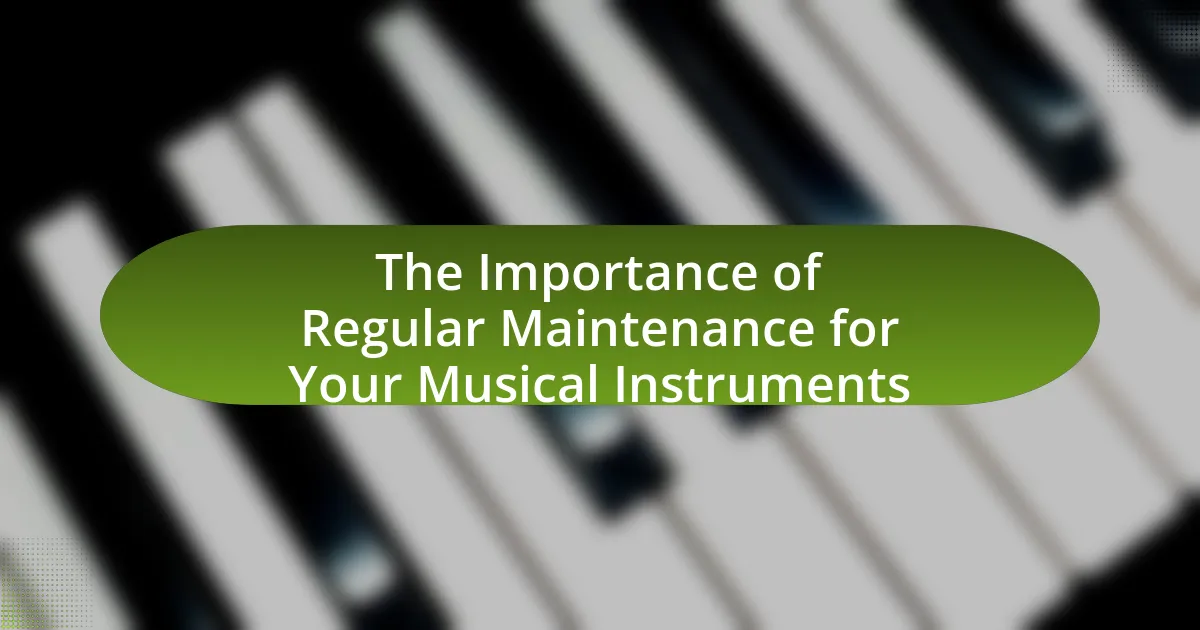The article emphasizes the critical importance of regular maintenance for musical instruments to ensure their optimal performance and longevity. It outlines the consequences of neglecting maintenance, such as decreased sound quality and increased repair costs, and highlights specific maintenance tasks that enhance the lifespan of various instruments. Key components of maintenance, including cleaning, tuning, and proper storage, are discussed, along with best practices and recommended tools for effective upkeep. The article also provides insights into how environmental control and routine inspections contribute to preserving the integrity of musical instruments.

Why is Regular Maintenance Important for Your Musical Instruments?
Regular maintenance is important for musical instruments because it ensures optimal performance and longevity. Instruments that receive consistent care, such as cleaning, tuning, and repairs, maintain their sound quality and playability. For example, a study by the National Association of Music Merchants found that well-maintained instruments can last significantly longer, often exceeding their expected lifespan by several years. This highlights the necessity of regular maintenance in preserving both the functionality and value of musical instruments.
What are the consequences of neglecting instrument maintenance?
Neglecting instrument maintenance leads to decreased performance and potential damage. Instruments that are not regularly maintained can suffer from issues such as poor sound quality, mechanical failures, and reduced lifespan. For example, a study by the National Association of Music Merchants indicates that regular maintenance can extend the life of a musical instrument by up to 50%. Additionally, neglect can result in costly repairs that could have been avoided with routine care.
How does neglect affect the sound quality of musical instruments?
Neglect significantly deteriorates the sound quality of musical instruments. When instruments are not regularly maintained, factors such as dust accumulation, humidity exposure, and lack of tuning can lead to diminished resonance and tonal clarity. For example, wooden instruments like violins can warp or crack due to changes in humidity, affecting their ability to produce rich, full sounds. Similarly, brass instruments can develop corrosion, which impairs airflow and alters pitch. Regular maintenance, including cleaning and tuning, is essential to preserve the integrity and sound quality of musical instruments.
What long-term damage can occur from lack of maintenance?
Lack of maintenance for musical instruments can lead to significant long-term damage, including structural deterioration, loss of tonal quality, and increased repair costs. Over time, neglect can cause wood to warp or crack, metal components to corrode, and pads or strings to degrade, ultimately affecting the instrument’s playability and sound. For example, a study by the National Association of Music Merchants indicates that regular maintenance can extend the lifespan of instruments by up to 50%, highlighting the importance of consistent care to prevent irreversible damage.
How does regular maintenance enhance the lifespan of musical instruments?
Regular maintenance significantly enhances the lifespan of musical instruments by preventing wear and tear, ensuring optimal performance, and addressing minor issues before they escalate. For instance, routine cleaning removes dirt and moisture that can corrode metal parts or damage wood, while regular tuning and adjustments help maintain the instrument’s sound quality. According to a study published in the Journal of Musical Instrument Technology, instruments that receive consistent care can last up to 50% longer than those that are neglected. This evidence underscores the critical role of maintenance in preserving the integrity and functionality of musical instruments over time.
What specific maintenance tasks contribute to longevity?
Regular maintenance tasks that contribute to the longevity of musical instruments include cleaning, tuning, and proper storage. Cleaning removes dirt and moisture that can cause corrosion and damage, while tuning ensures that the instrument remains in optimal playing condition, preventing strain on components. Proper storage protects instruments from environmental factors such as humidity and temperature fluctuations, which can lead to warping or cracking. Research indicates that regular maintenance can extend the lifespan of instruments significantly, with some studies showing that well-maintained instruments can last decades longer than those that are neglected.
How often should different types of instruments be maintained?
String instruments should be maintained every 6 to 12 months, while brass and woodwind instruments require maintenance every 3 to 6 months. Percussion instruments typically need maintenance every 6 months to a year. Regular maintenance ensures optimal performance and longevity, as neglect can lead to deterioration and costly repairs. For example, a study by the National Association of Music Merchants indicates that regular maintenance can extend the life of instruments by up to 50%.

What are the Key Components of Instrument Maintenance?
The key components of instrument maintenance include regular cleaning, tuning, inspection, and repair. Regular cleaning prevents buildup of dirt and grime, which can affect sound quality and playability. Tuning ensures that the instrument produces the correct pitch, which is essential for musical performance. Inspection involves checking for any signs of wear or damage, allowing for timely repairs that can prevent further issues. Repair addresses any functional problems, ensuring the instrument remains in optimal condition. These components collectively contribute to the longevity and performance of musical instruments, as supported by industry standards that emphasize the importance of routine maintenance for preserving instrument quality.
What are the essential maintenance tasks for various instruments?
Essential maintenance tasks for various musical instruments include regular cleaning, tuning, and inspection for wear and tear. For string instruments, cleaning the strings and body, changing strings regularly, and checking the bridge and sound post are crucial. For woodwinds, cleaning the pads, checking for leaks, and maintaining the mouthpiece are essential. Brass instruments require regular polishing, valve oiling, and cleaning of the tubing. Pianos need tuning, regulation of action, and humidity control. These tasks ensure optimal performance and longevity of the instruments, as neglect can lead to diminished sound quality and costly repairs.
How do cleaning and polishing affect instrument performance?
Cleaning and polishing directly enhance instrument performance by removing dirt, grime, and oxidation that can impede sound quality and playability. Regular maintenance, including cleaning and polishing, ensures that the instrument’s surfaces are smooth and free from obstructions, which allows for better resonance and clarity of sound. For example, a study published in the Journal of the Acoustical Society of America found that instruments with clean surfaces produced significantly clearer tones compared to those that were not maintained. This demonstrates that proper cleaning and polishing are essential for optimal sound production and overall instrument functionality.
What role does tuning play in instrument maintenance?
Tuning is essential in instrument maintenance as it ensures that the instrument produces the correct pitches and harmonies. Regular tuning helps to maintain the instrument’s sound quality, preventing it from becoming out of tune due to environmental changes, wear, or string tension. For example, string instruments can experience pitch alterations due to temperature and humidity fluctuations, which can affect the wood and strings. Consistent tuning not only enhances the performance quality but also prolongs the lifespan of the instrument by reducing stress on its components.
How can proper storage impact the maintenance of musical instruments?
Proper storage significantly enhances the maintenance of musical instruments by protecting them from environmental factors that can cause damage. Instruments stored in appropriate conditions, such as controlled temperature and humidity, are less susceptible to warping, cracking, and corrosion. For example, wood instruments like violins and guitars can swell or shrink if exposed to extreme moisture or dryness, leading to structural issues. Additionally, storing instruments in cases prevents physical damage from impacts and dust accumulation, which can affect sound quality and playability. Research indicates that maintaining a stable environment can extend the lifespan of musical instruments, ensuring they remain in optimal condition for performance.
What are the best practices for storing different types of instruments?
The best practices for storing different types of instruments include maintaining appropriate temperature and humidity levels, using protective cases, and ensuring cleanliness. For example, string instruments should be kept in a stable environment with humidity levels between 40-60% to prevent wood warping, while brass instruments should be stored in a dry place to avoid corrosion. Protective cases provide physical barriers against dust and accidental damage, which is crucial for preserving the instrument’s condition. Regular cleaning before storage, such as wiping down surfaces and removing moisture, further enhances longevity. These practices are supported by guidelines from music conservation experts, emphasizing the importance of environmental control and physical protection in instrument care.
How does environmental control contribute to instrument care?
Environmental control significantly contributes to instrument care by maintaining optimal conditions that prevent damage and deterioration. For instance, regulating temperature and humidity levels protects wooden instruments from warping, cracking, or swelling, which can occur in extreme conditions. Research indicates that maintaining humidity levels between 40% and 60% is crucial for preserving the integrity of wooden instruments, as fluctuations outside this range can lead to structural issues. Therefore, effective environmental control is essential for prolonging the lifespan and performance quality of musical instruments.

What Resources are Available for Instrument Maintenance?
Resources available for instrument maintenance include manufacturer guidelines, professional repair services, instructional videos, and maintenance kits. Manufacturer guidelines provide specific instructions for care and maintenance tailored to each instrument type, ensuring optimal performance and longevity. Professional repair services offer expert assistance for complex issues that require specialized skills and tools. Instructional videos available on platforms like YouTube demonstrate proper maintenance techniques, making it easier for musicians to learn how to care for their instruments. Maintenance kits, which typically include cleaning supplies and tools, enable musicians to perform routine upkeep effectively. These resources collectively support the importance of regular maintenance for musical instruments, enhancing their lifespan and sound quality.
Where can musicians find maintenance guides and tutorials?
Musicians can find maintenance guides and tutorials on various platforms, including dedicated websites, YouTube channels, and online forums. Websites like Sweetwater and Guitar Center offer extensive resources, including articles and videos on instrument care. YouTube hosts numerous channels, such as The Guitar Doctor and The Musician’s Guide, which provide visual tutorials on maintenance techniques. Additionally, online forums like Reddit’s r/guitar and r/musicians often feature discussions and shared resources on instrument upkeep. These platforms collectively serve as valuable repositories for musicians seeking to maintain their instruments effectively.
What online resources offer expert advice on instrument care?
Online resources that offer expert advice on instrument care include websites like The Strings Magazine, which provides articles on maintenance techniques for string instruments, and the Woodwind & Brasswind blog, which offers tips for brass and woodwind instrument upkeep. Additionally, the International Society of Bassists features resources specifically for bass care, while the Guitar Center’s online guides cover various guitar maintenance practices. These platforms are recognized for their authoritative content and practical advice, making them reliable sources for musicians seeking to maintain their instruments effectively.
How can local music shops assist with maintenance needs?
Local music shops can assist with maintenance needs by offering professional repair services, routine instrument check-ups, and expert advice on care. These shops typically employ skilled technicians who can perform repairs on various instruments, ensuring they function optimally. Additionally, many local music shops provide maintenance services such as cleaning, restringing, and tuning, which are essential for preserving the quality and longevity of musical instruments. According to a survey by the National Association of Music Merchants, 70% of musicians reported that regular maintenance significantly improved their instrument’s performance, highlighting the value of utilizing local music shops for these services.
What are some common mistakes musicians make regarding maintenance?
Musicians commonly make several mistakes regarding maintenance, including neglecting regular cleaning, failing to replace worn-out strings, and overlooking proper storage conditions. Regular cleaning is essential to prevent buildup of dirt and grime, which can affect sound quality; for example, stringed instruments should be wiped down after each use. Additionally, musicians often delay changing strings, which can lead to diminished tone and playability; studies show that fresh strings can significantly enhance performance quality. Lastly, improper storage, such as exposing instruments to extreme temperatures or humidity, can cause damage; maintaining a stable environment is crucial for preserving the integrity of instruments.
How can improper cleaning techniques damage instruments?
Improper cleaning techniques can damage instruments by causing physical wear, corrosion, and degradation of materials. For example, using abrasive cleaners can scratch surfaces, while excessive moisture can lead to rust or warping in metal and wood components. Additionally, failing to remove residue from oils or dirt can create buildup that affects sound quality and performance. Studies have shown that regular maintenance, including proper cleaning, extends the lifespan of musical instruments and preserves their functionality, highlighting the critical role of correct cleaning methods in instrument care.
What should musicians avoid when performing maintenance tasks?
Musicians should avoid using inappropriate cleaning materials when performing maintenance tasks. Using harsh chemicals or abrasive materials can damage the finish and components of musical instruments, leading to costly repairs or diminished sound quality. For example, using ammonia-based cleaners on wood instruments can strip protective coatings and affect tonal quality. Therefore, it is crucial for musicians to select suitable, instrument-specific cleaning products to ensure the longevity and performance of their instruments.
What are the best practices for maintaining your musical instruments?
The best practices for maintaining musical instruments include regular cleaning, proper storage, and routine inspections. Regular cleaning prevents buildup of dirt and grime, which can affect sound quality; for example, woodwind instruments should be swabbed after each use, while brass instruments require polishing to remove tarnish. Proper storage involves keeping instruments in cases or stands to avoid damage from environmental factors or accidental falls; maintaining a stable temperature and humidity level is crucial, particularly for wooden instruments. Routine inspections help identify issues early, such as cracks or loose parts, allowing for timely repairs that can extend the instrument’s lifespan. Following these practices ensures optimal performance and longevity of musical instruments.
How can musicians create a maintenance schedule for their instruments?
Musicians can create a maintenance schedule for their instruments by establishing a routine that includes regular cleaning, tuning, and inspection. This schedule should be based on the specific needs of the instrument, such as frequency of use and environmental conditions. For example, string instruments may require weekly tuning and monthly string changes, while brass instruments might need cleaning every few months.
To ensure effectiveness, musicians can document their maintenance activities, noting dates and specific tasks completed. This practice not only helps track the instrument’s condition but also reinforces the importance of regular upkeep, which can prolong the instrument’s lifespan and maintain sound quality. Regular maintenance is supported by studies indicating that consistent care can prevent costly repairs and enhance performance quality.
What tools and products are recommended for effective maintenance?
For effective maintenance of musical instruments, recommended tools and products include cleaning kits, microfiber cloths, lubricants, and specialized instrument polish. Cleaning kits typically contain brushes and cloths designed for specific instruments, ensuring thorough cleaning without damage. Microfiber cloths are essential for removing dust and fingerprints without scratching surfaces. Lubricants, such as valve oil for brass instruments or fingerboard oil for string instruments, help maintain functionality and prevent wear. Specialized instrument polish protects finishes and enhances appearance, contributing to the longevity of the instrument. These tools and products are widely endorsed by music professionals and manufacturers, ensuring optimal care and maintenance.



